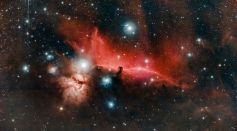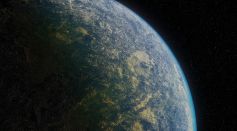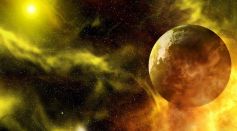Tags: Planets
Aliens May Be Using Greenhouse Gases to Make Planets or Exoplanets Habitable

Binary Star Systems: Can They Teach Us How Planets Form?
Protoplanetary Disks Around Tiny Stars Are Chemically Distinct From Those Surrounding the Sun, May Influence Atmosphere of Forming Planets
Sat-Nav in Space: Best Route Between Two Worlds Calculated Using 'Knot Theory' [Study]
Stellar Appetites Unveiled: Twin Star Studies Shed Light on the Frequency of Stars Devouring Their Planets
James Webb Telescope Spots Complex Organic Molecules Near Forming Stars, Revealing Planetary Origins
Aliens Stuck in Their Own Planets? New Study Argues That Physical Limitations Could Be Trapping Extraterrestrial Life, Drake Equation Could Be Insufficient
Venus-Mars Conjunction Happening Soon: Here's How To Catch the Two Planets Side by Side

Distant Giant Planets Begin as Flattened Disks, Transforming into Round Shapes Over Time

Earth Was Once Flat 'Like a Smartie' Before Adopting Its Modern Spherical Shape, Researchers Suggest
Primordial Black Holes May Alter Earth’s Orbit, Cause Planets and Moons Near Us to Wobble

Why Study Space? Top 4 Reasons How It Enhances Understanding of Life on Earth

Five Rocky Planets Might Be Existing in the Outer Bounds of the Solar System, New Research Suggests
New Image of Neptune Shows It Has Similar Color to Planet Uranus

Alien Life Could Be Indicated by Low Carbon Dioxide Levels on Distant Planets; NASA's James Webb Telescope at the Helm

How Many Times Did Each Planet in the Solar System Orbited the Sun? Scientists Explain Their Orbital Period
NASA's Kepler Telescope Data Unveils a Planetary System With Seven Hot, Large Exoplanets
JWST Discovers Dozens of Planet-Like Objects Untethered to Any Star in Trapezium Cluster

James Webb Space Telescope Finds Numerous Starless Jupiter-Sized Planets in New Orion Nebula Survey

Exploring the Origins of Exocontinents: How Plate Tectonics Shapes Habitable Worlds
Most Popular

Largest Known Volcanic Aquifer Discovered Beneath Oregon's Cascades

New 'Supergiant' Sea Bug Found in South China Sea, Named After Darth Vader

Mediterranean Sea Was Refilled by a Catastrophic Flood Millions of Years Ago

Mysterious Cosmic Waves That Sound Like Birds Detected in Unexpected Space Region





